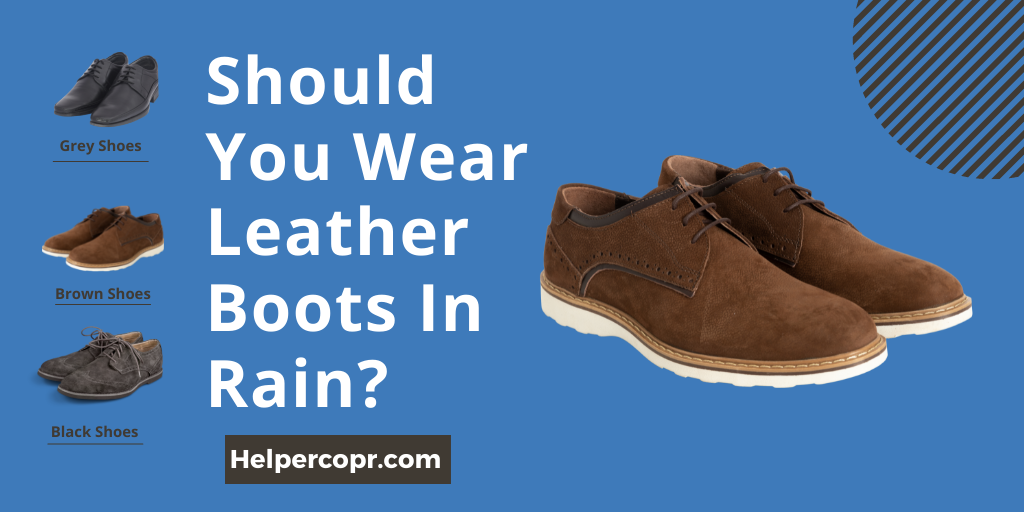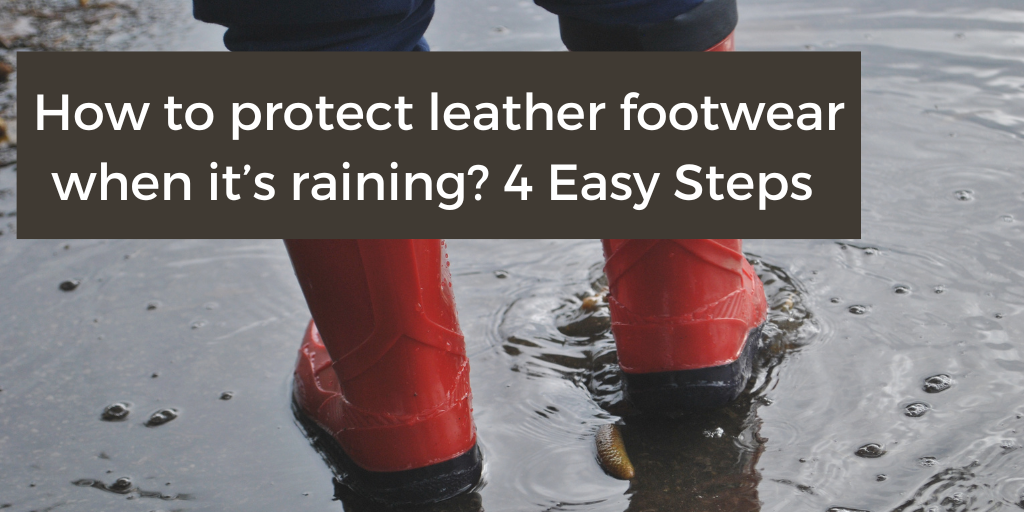
When the weather forecast calls for rain, it is recommended that you wear boots made of leather. But to what most people believe, I wouldn’t recommend that you wear leather boots in the wet weather. They will just become wetter. There is a high probability that water will seep into the shoes, and this may result in a variety of complications. The dampness from the rains might potentially cause the metal zippers, glues, decorations, or insoles to get ruined.
Why does water cause the leather to deteriorate more quickly than other substances?
Leather is often a porous material that has the ability to absorb water when it comes into touch with the liquid. In particular, on days when it is raining, the leather shoes get thoroughly drenched to a higher level. Even after it has been dried out, the material will be irreparably damaged because of the water that it absorbed, which will manifest as cracks on the surface.
When compared to other materials, genuine leather has a longer lifespan and is more environmentally friendly than other options. It outperforms the other materials in terms of its strength. If your shoe is constructed entirely of leather, then you may confidently wear it in any kind of weather. It is capable of adapting to a variety of environments and can handle any situation that may arise. When it comes into touch with precipitation, genuine leather will not suffer significant damage right away. In addition to while it is raining, it may also be worn when there is low ice or throughout the winter.

Methods & supplements to avoid cracks while wearing shoes in the rain.
| Methods to prevent | Supplements to prevent |
| Regular cleansing | Waterproofing cream |
| Weatherproofing | Shoe conditioners |
| Using waterproof covers | Applying beeswax cream |
How Can You Keep Your Leather Shoes From Getting Wet?
When it rains severely, we may avoid wearing leather shoes. However, you cannot prevent your shoes from being wet when unexpected events occur, such as falling into a muddy ditch or sudden rain. In such a case, let us look at the many methods and preventative measures that can be taken to preserve the leather shoes from dampness.
1. Keep your boots clean.
To prevent situations like this, keep your shoes clean and neat, and wash them on a regular basis. Make sure that the boots are cleaned at regular intervals. Make use of the available equipment to remove heavy dirt from the shoes. For example, use stiff shoe brushes to remove debris before it enters the deeper surface of the leather. If it penetrates far enough, it may cause harm to the shoes’ core material. Using clothes to remove stains is the most effective way to maintain and protect the boots.
2. Weatherproofing
Weatherproofing is the practice of putting a layer of wax as a long-lasting coating on leather shoes to protect them from harm. It is the most important way of preserving leather shoes, and it entails vital procedures in the process. The use of wax will prevent water absorption and the formation of cracks. Although the procedure is beneficial, it is not often recommended. This is due to the wax covering eventually depleting. To keep the wax coating for a long time, this method must be performed once every 15 days. Purchase water-resistant footwear made of waterproof material. Such material has great potential and is resistant to water.
3. Think About Buying A Waterproof Cover
Assume you reside in an area where it rains regularly. You can’t always avoid wearing leather shoes. In such a scenario, you may use waterproof coverings to protect your leather shoes from precipitation. Always keep a pair of shoes in your backpack in case of an emergency. Premium leather shoes are particularly costly and valuable, so adequate precautions must be taken to protect them.
What Should You Do If You Get Your Leather Shoes Wet?
1. Shoes that dry quickly
First and foremost, after getting your leather shoes wet, you should quickly dry them. It is critical to dry it as soon as you get wet. To ensure long-term sustainability, ensure that the moisture content is completely dried out. To preserve the inside layer of the shoes, insert a shoe tree.
If your feet become wet while wearing the shoes, the shoe tree will protect them. To minimize pain, make sure your feet are dry before putting on shoes. In natural conditions, the weather will dry faster. You may also use a hairdryer to dry it. It is not necessary to keep it near the fireplace or in the vicinity of the heater.
2. Restore moisturization
Second, after drying the shoes, use shoe conditioners to keep the moisture content of the boots. It will assist you in restoring the elasticity of the leather and preventing a crack from forming. Use a nickel-sized quantity of conditioner and apply it using cotton, soft sponge, or cloth to ensure that all shoe sections are covered. Before applying the conditioner, remove the shoelaces.

How to protect leather footwear when it’s raining? 4 Easy Steps
Pure leather is often robust, but it is a porous substance that absorbs a significant quantity of water when in contact with water. In general, it is not waterproof. Water resistance is naturally achieved by weatherproofing or another easy procedure.
Weatherproofing or spraying waterproof compounds on the exterior surface are the most common ways to keep it from becoming wet. Applying beeswax ointment is also an excellent approach for avoiding shoes to the greatest extent possible. Before putting any product on your leather shoes, bags, or chairs, test it by applying it to the exterior surface.
It is done to avert future problems. If you want to protect your leather items organically, follow these steps to make beeswax cream at home. The majority of individuals utilize this handy waterproof material.
Ingredients
- 1 cup olive oil (extra virgin)
- 2 oz. of beeswax
- Coldwater
- A glass jar
- Cotton clothing
1. Combine the ingredients.
Pour the extra virgin olive oil into a glass container. Break the beeswax into small pieces and add it to the mixture. Fill the jar halfway with cold water.
2. Heat
To get a flawless blend with extra virgin olive oil, heat the combination content to melt the beeswax.
3. Cool
Remove the mixture from the heat and thoroughly combine it without burning your fingers. Continue to mix until the mixture becomes chilly and stiff. The procedure must be completed in no more than 20 minutes.
4. Apply
After thoroughly blending the components and letting the mixture cool, apply the mixture to the surface layer to ensure it does not hurt the leather. Once completed, use delicate clean clothes to apply it completely to the exterior surface of the leather shoes. Apply the coating with caution; this is the boots’ inherent resistance.
After you have made the decision to leather proof your shoes, it is imperative that you do an extensive amount of study prior to beginning the procedure and investigate a variety of leather proofing techniques. To keep your shoes neat and clean, you should use cleaning products and chemicals that waterproof them. When it comes to having shoes for a lengthy amount of time, cleanliness is the single most important issue that must be addressed. To avoid differences, you can take good care of it, add conditioners, and dry it quickly after it gets wet.
FAQs
1. When leather shoes are wet, does this cause the leather to crack?
When it becomes wet or moist, there is a good chance that cracks may form due to the stress put on it.
2. What is the most effective method for preventing water from seeping into leather shoes?
The greatest approach to protecting shoes is to weatherproof them.
3. Can you wear Leather Boots in the snow?
Can you wear leather boots in the rain, someone may question. The answer is Yes. You may! So, the following question arises: Are leather boots suitable for use in snow? It varies since leather boots are also susceptible to snow. Snow may get into your boots via the bottom while it is snowing. It may result in leather cracks.
Conclusion on How to Protect Leather Footwear in Rain
Plastic bags are widely accessible and may be carried with you. Two large plastic bags will suffice. If it begins to rain, you may cover your shoes with those plastic bags to keep the water out. I hope this article has helped you gain some new perspective on can you wear leather shoes in the rain.
